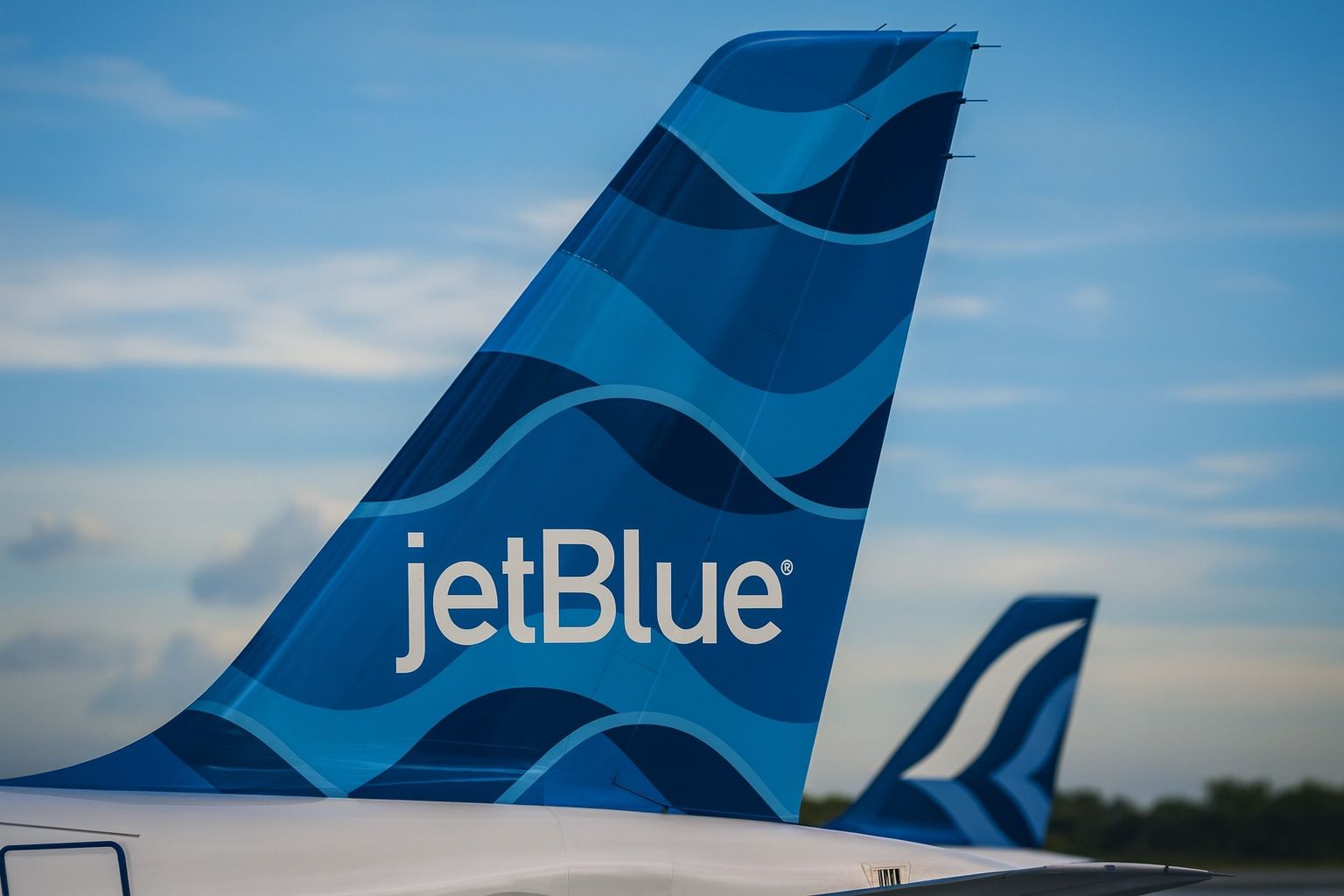- JetBlue’s Share Slide: JetBlue (JBLU) stock has fallen ~41% so far in 2025, prompting analyst warnings. On Oct 10 Weiss Ratings gave JetBlue a rare “sell (D-)” rating, citing weak performance [1]. Most Wall Street firms now rate JBLU a “hold” or “sell” with a consensus 12‑month target just $5.28 [2] (against a current price around $4.40).
- American Airlines Update: By contrast, American Airlines (AAL) saw its price target raised by Susquehanna to $12 (from $10) on Oct 9, though the firm kept a Neutral rating [3]. Overall, 19 analysts give AAL a Moderate Buy consensus – price targets range $10–$20 with an average about $16.6 [4]. American topped Q3 earnings forecasts ($0.95 EPS vs $0.79 est.) [5], bolstering hopes for a recovery.
- Big Carrier Performance: Major airlines are generally riding a travel boom. Delta Air Lines blew past Q3 estimates (adj. EPS $1.71 vs $1.52 exp.) and raised full-year guidance [6]. CEO Ed Bastian said “momentum is continuing” and that Delta is “well positioned” to grow [7]. Delta’s stock jumped +5% on the news, and “the optimism spread to other airlines” – United, American, JetBlue and Alaska all popped 2–5% [8]. For United, Wall Street is still bullish: it carries a Buy consensus and average 12‑month target ~$120 (≈+23% upside) [9].
- Industry Trends: Travel demand is red‑hot: IATA forecasts 2025 industry revenue >$1 trillion and record profit ($36.6B) on 5.2 billion passengers [10]. Airlines have trimmed capacity (Spirit’s bankruptcy and fleet cuts are tightening seats) which is driving up fares. Indeed, U.S. airlines report surging “premium” ticket sales: Delta said premium cabin revenue jumped ~9% YoY [11]. With Spirit out of the market, Delta noted capacity tightening will “keep fares high” [12].
- Risks Ahead: Offsetting the tailwinds, costs are squeezing carriers. JetBlue’s Q3 guidance showed fuel savings but still forecast a 1.5–4% drop in unit revenue and a 3.5–5.5% rise in non-fuel unit costs [13]. A prolonged U.S. government shutdown has created delays (over 3,000 flights/day), though analysts note stocks have been “largely unfazed” so far [14]. Still, CEOs warn that an extended shutdown or renewed inflation could dent holiday travel.
- Analyst Outlook: On price targets, American’s ~12‑month consensus is well above today’s ~$11–12 stock price (implying ~30–40% upside) [15]. JetBlue’s consensus target (~$5.28 [16]) is only ~20% above current levels. In short, analysts see American Airlines as a moderate buy with improving fundamentals, while JetBlue is under pressure with a “Reduce” consensus and deep balance‑sheet challenges [17].
JetBlue’s Slide and Ratings
JetBlue’s stock has been battered recently. Despite raising its Q3 guidance in September (strong late-summer bookings and cheaper fuel allowed JetBlue to tighten capacity and increase revenue forecasts [18] [19]), investors remain skeptical. The airline’s Jul–Sep earnings showed a loss of $0.16 per share (worse than many peers) [20]. JetBlue’s heavy debt load and sub‐1x price/sales make it vulnerable as yields soften. Credit and equity analysts are cautious: Weiss Ratings’ Oct 9 report gave JBLU a “sell (D-)” rating [21]. MarketBeat notes that 7 analysts now rate JBLU Hold and 5 rate Sell, yielding a consensus price target of just $5.28 [22]. (By comparison JetBlue traded around $8.30 in late 2024.)
JetBlue management insists conditions are improving. The company says it has largely overcome prior engine problems and expects “long-term growth” from 2026 as newer A320neo jets return to service [23]. It is also partnering with United on an interline deal to boost revenue. But in the near term, high operating costs and competition are weighing. As one analyst put it, the sector is in the “early-to-middle innings of a wholesale change” driven by new technology and shifting travel habits [24]. JetBlue must show that its “JetForward” premium strategy can translate to profits. If not, many investors fear more downside – which explains the stock’s deep drawdown.
American Airlines: Cautious Optimism
American Airlines is in better shape. Susquehanna’s Christopher Stathoulopoulos recently raised his 12‑month target on AAL to $12 (from $10) [25], keeping a neutral call as he prepares for the earnings season. Other brokers are more bullish: UBS, Jefferies and even JPMorgan have lifted targets into the mid‑teens (JPMorgan’s overweight target is $20 [26]). In fact, MarketBeat reports that 19 firms cover AAL with a consensus Moderate Buy rating; their average price target is about $16.59 [27].
Fundamentally, American just topped earnings and revenue estimates. Q3 results (reported early October) showed EPS $0.95 vs $0.79 expected [28], on $14.39B of revenue. Like its rivals, American benefitted from higher fares; its CEO Robert Isom noted a rebound in corporate travel and premium cabin demand. The airline has also been cutting costs and parking older planes. Over 50% of AAL is owned by institutions, indicating strong investor interest [29]. Taken together, analysts see some upside: at roughly $11–12 a share today, even a $12–15 target implies a tidy gain if travel stays hot.
Strong Carriers & Travel Boom
Results from Delta and United underscore the robust backdrop. Delta’s blowout Q3 and aggressive guidance revisions have lifted the entire sector. Delta announced $1.42B in Q3 net income ($1.71 adj. EPS) on $16.67B revenue [30]. CEO Ed Bastian touted “strong execution and improving fundamentals” and projected 2025 EPS ~$6.00 (ahead of earlier guidance) [31]. U.S. airline capacity has been deliberately restrained this year – a factor that has pushed average fares higher. Reuters notes that Delta cut main cabin seats to book more premium seats, resulting in premium revenues jumping ~9% [32]. Bastian said the carrier remains “well positioned” to continue revenue growth [33].
The market’s reaction was telling: Delta shares popped 5% on the earnings beat, and all major U.S. airlines jumped in sympathy [34]. United (set to report soon) also enjoyed a rally. TS2 reports a consensus “Buy” rating on UAL with ~17 analysts eyeing a rally toward $120 [35]. United’s CEO Scott Kirby echoed the bullish tone, commenting that “the world is less uncertain today” and that he expects a strong year-end [36]. Indeed, UAL announced new international routes and a return of more transatlantic flying – moves that suggest confidence in leisure travel demand [37].
Underlying all this is recovering global travel. Industry data from IATA shows airlines are forecasting 2025 revenues exceeding $1 trillion and $36.6 billion in profit on a record 5.2 billion passengers [38]. Jet fuel prices have actually eased (IATA forecasts fuel prices down next year) [39], offering cost relief. Capacity constraints like late plane deliveries have also kept supply snug. This environment – booming demand, higher fares, limited seats – has been described as a “wholesale change” in the airline industry [40].
What’s Next: Forecasts and Risks
Looking ahead, analysts are cautiously optimistic on the big carriers but divided on JetBlue. If demand holds, carriers like Delta, United and American could continue to generate healthy cash flows and reward shareholders. Market consensus for UAL and DAL remains generally bullish, and IATA’s positive outlook supports that. On the other hand, smaller carriers and low-cost operators face an uncertain future: Spirit and Frontier have slashed capacity under bankruptcy, leaving legacy airlines to grab more customers [41] [42].
For JetBlue shareholders, however, forecasts are grim. MarketBeat notes 7 Holds and 5 Sells on JBLU with a consensus “Reduce” rating [43]. At roughly $4.40 today, a $5.28 target implies just ~20% upside over a year – hardly compelling, given risks. In contrast, American’s ~$12 target vs ~$11 stock suggests ~10% upside even before hitting $16+ targets that some bulls expect.
In sum, the sector’s key fact is divergence: legacy carriers appear to be capitalizing on the travel boom (as Delta’s CEO put it, “momentum is continuing” [44]), whereas JetBlue is struggling under its cost structure and weak pricing power. The next earnings reports and holiday travel season will be telling. Investors are watching interest rate moves, oil prices, and policy risks (e.g. the U.S. shutdown) that could suddenly cast a chill. For now, experts urge a cautious approach. As one strategist warned, airlines may still encounter “turbulence” if any of these headwinds strengthen – so keep an eye on the gauges.
Sources: Reports from MarketBeat [45] [46], TipRanks/TheFly [47], TS2.tech analysis [48] [49] [50], FlightGlobal [51], and Reuters [52]. (Stock prices as of Oct 11–12, 2025.)
References
1. www.marketbeat.com, 2. www.marketbeat.com, 3. www.tipranks.com, 4. www.marketbeat.com, 5. www.marketbeat.com, 6. ts2.tech, 7. ts2.tech, 8. ts2.tech, 9. ts2.tech, 10. www.reuters.com, 11. ts2.tech, 12. ts2.tech, 13. www.ainvest.com, 14. ts2.tech, 15. www.marketbeat.com, 16. www.marketbeat.com, 17. www.marketbeat.com, 18. www.flightglobal.com, 19. www.flightglobal.com, 20. www.marketbeat.com, 21. www.marketbeat.com, 22. www.marketbeat.com, 23. www.flightglobal.com, 24. www.tipranks.com, 25. www.tipranks.com, 26. www.marketbeat.com, 27. www.marketbeat.com, 28. www.marketbeat.com, 29. www.marketbeat.com, 30. ts2.tech, 31. ts2.tech, 32. ts2.tech, 33. ts2.tech, 34. ts2.tech, 35. ts2.tech, 36. ts2.tech, 37. ts2.tech, 38. www.reuters.com, 39. www.reuters.com, 40. www.tipranks.com, 41. ts2.tech, 42. www.reuters.com, 43. www.marketbeat.com, 44. ts2.tech, 45. www.marketbeat.com, 46. www.marketbeat.com, 47. www.tipranks.com, 48. ts2.tech, 49. ts2.tech, 50. ts2.tech, 51. www.flightglobal.com, 52. www.reuters.com










